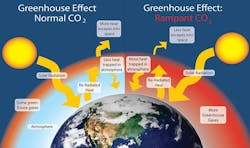NOAA joins EPRI initiative on studying Climate Risks in the Energy Sector
The Electric Power Research Institute and National Oceanic and Atmospheric Administration are entering into a three-year focus on developing a scientifically based approach to climate risk assessment in the energy sector.
With extreme weather getting more extreme (see wildfires in California, drought in western U.S., floods in Kentucky and much more), the three-year memorandum of understanding (MOU) between EPRI and NOAA builds on finding a consistent approach to understanding risk in weather intensity as it relates to energy output. The two organization agreed to share publicly available knowledge, data, research and new ideas related to physical climate risk assessment.
Many experts believe the changing climate is directly related to the rising carbon and other air pollutant emissions from industrialization and power generation activities. Earlier this year, EPRI launched an initiative to gather industry leaders and stakeholders to address how to best meet resiliency and sustainability goals.
NOAA is one of the first governmental entities to join the effort.
"Proactively strengthening grid resilience against potential climate and weather impacts is going to take unprecedented collaboration among a diverse set of stakeholders," said EPRI President and CEO Arshad Mansoor, Ph.D. "NOAA is world-renowned for its weather and climate monitoring and modeling. EPRI and NOAA complement one another's skillsets and together can bring to the table further credibility and science as we collectively tackle this pressing challenge."
The global mean temperature has risen about 2 degrees Fahrenheit since the start of the Industrial Revolution in the 19th century, a factor which many believe has helped intensify extreme weather events. Currently, human activities release more than 30 billion tons of carbon dioxide and nearly three times the concentration of methane, according to the data from NOAA.
"NOAA's trusted climate data and tools help empower individuals, communities, and businesses to understand the risks from climate and extreme weather events and make informed decisions," said NOAA Administrator Rick Spinrad, Ph.D. "This transformational partnership with EPRI allows NOAA to provide climate data to a critical industry and helps the agency understand the energy sector to better anticipate future information delivery needs---laying the foundation for a Climate-Ready Nation."
So far, EPRI has brought in 22 stakeholders, including NOAA, to its Climate READi public framework. Founding members of the collaboration included energy companies such as Ameren, Alliant, American Electric Power, Exelon, National Grid, New York Power Authority, Pacific Gas & Electric, Southern Co. and WEC Energy Group.
-- -- --
(Rod Walton, senior editor for EnergyTech, is a 14-year veteran of covering the energy industry both as a newspaper and trade journalist. He can be reached at [email protected]).
About the Author
Rod Walton, EnergyTech Managing Editor
Managing Editor
For EnergyTech editorial inquiries, please contact Managing Editor Rod Walton at [email protected].
Rod Walton has spent 17 years covering the energy industry as a newspaper and trade journalist. He formerly was energy writer and business editor at the Tulsa World. Later, he spent six years covering the electricity power sector for Pennwell and Clarion Events. He joined Endeavor and EnergyTech in November 2021.
Walton earned his Bachelors degree in journalism from the University of Oklahoma. His career stops include the Moore American, Bartlesville Examiner-Enterprise, Wagoner Tribune and Tulsa World.
EnergyTech is focused on the mission critical and large-scale energy users and their sustainability and resiliency goals. These include the commercial and industrial sectors, as well as the military, universities, data centers and microgrids. The C&I sectors together account for close to 30 percent of greenhouse gas emissions in the U.S.
He was named Managing Editor for Microgrid Knowledge and EnergyTech starting July 1, 2023
Many large-scale energy users such as Fortune 500 companies, and mission-critical users such as military bases, universities, healthcare facilities, public safety and data centers, shifting their energy priorities to reach net-zero carbon goals within the coming decades. These include plans for renewable energy power purchase agreements, but also on-site resiliency projects such as microgrids, combined heat and power, rooftop solar, energy storage, digitalization and building efficiency upgrades.

